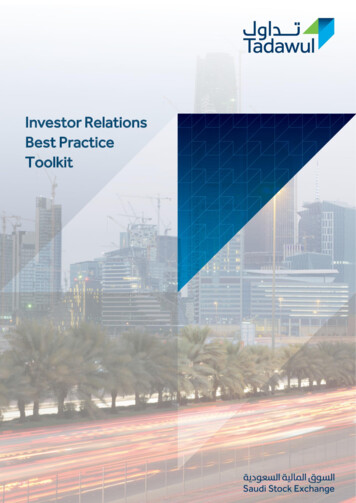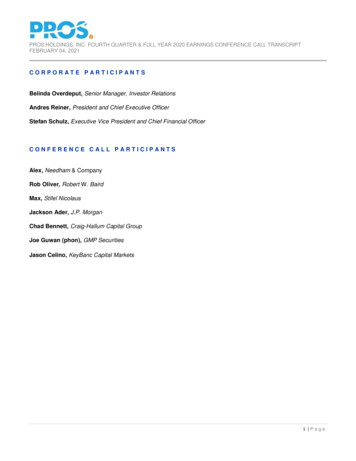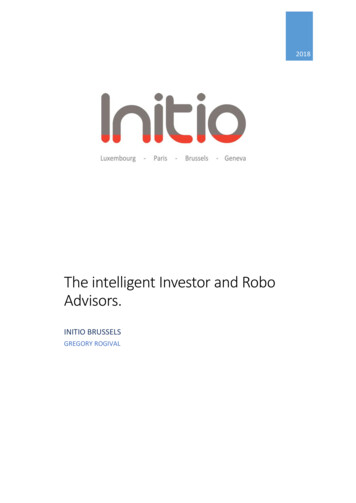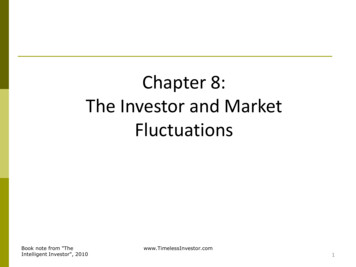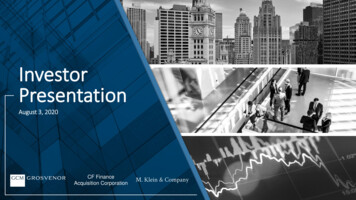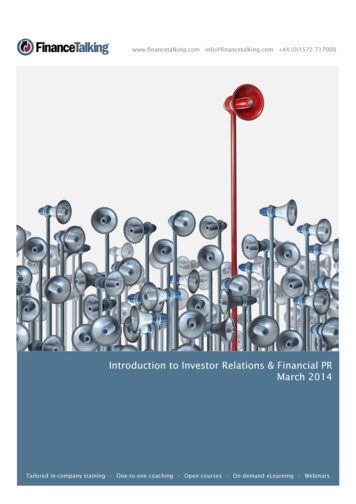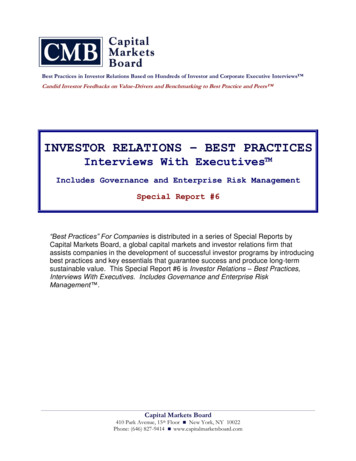
Transcription
Best Practices in Investor Relations Based on Hundreds of Investor and Corporate Executive Interviews Candid Investor Feedbacks on Value-Drivers and Benchmarking to Best Practice and Peers INVESTOR RELATIONS – BEST PRACTICESInterviews With Executives Includes Governance and Enterprise Risk ManagementSpecial Report #6“Best Practices” For Companies is distributed in a series of Special Reports byCapital Markets Board, a global capital markets and investor relations firm thatassists companies in the development of successful investor programs by introducingbest practices and key essentials that guarantee success and produce long-termsustainable value. This Special Report #6 is Investor Relations – Best Practices,Interviews With Executives. Includes Governance and Enterprise RiskManagement .Capital Markets Board410 Park Avenue, 15th Floor New York, NY 10022Phone: (646) 827-9414 www.capitalmarketsboard.com
INVESTOR RELATIONS – BEST PRACTICES, INTERVIEWS WITH EXECUTIVES IntroductionAt no time in recent history have executives faced challenges as they have since the changingmarkets and global economic crisis unfolded dramatically in 2008. This series brings today’smanagers and professionals the fundamental information they need to stay competitive in a fastmoving world. From the preeminent thinkers whose work has defined an entire field to the risingstars who will redefine the way we think about investor relations, here are the leading minds andlandmark ideas.In their own words, prominent executives share their insights and thoughts on cutting edge issuesand timeless topics. Combined, these interviews create perhaps the most stimulating publicationon the latest thinking in investor relations, governance, and enterprise risk management.Most professionals are so busy with the day-to-day requirements of the job that they're unable tocarve out time for true career development and personal brand building. Fast, punchy andprescient, these interviews are worth bookmarking today for greater job security, value andrecognition tomorrow.Investor Relations Best Practices series of reports in this collection are available in individualreports on the Capital Markets Board website at www.capitalmarketsboard.com. Eachpublication gathers together separate but related articles on investor relations, governance, andenterprise risk management.Sincerely,Jeff Christensen, CPAManaging PartnerCapital Markets BoardAll rights reserved. No part of this document may be reproduced, stored in a retrieval system, ortransmitted, in any form or by any means, electronic, mechanical, photocopying, recording,or otherwise without the prior written permission of Capital Markets Board.2Capital Markets BoardProviding Investor Feedback on the Company’s Credibility and Growth StrategiesResearching Investor Misperceptions Positioning Strategists Targeting & Qualifying Potential Investors
INVESTOR RELATIONS – BEST PRACTICES, INTERVIEWS WITH EXECUTIVES INTERVIEW QUESTIONS & ANSWERSInterview Topics Within This ReportTopicIntroductionPage2A. How Companies Are Adapting to the Changing Corporate Governance Landscape,Including the Dodd-Frank Act and Guidance From SEC4B. How Investor Relations Has Been Most Helpful To Investors8C. How Investor Relations Has Been Most Helpful To Management11D. Strategic Investor Relations Adds Value to Management and Investors16E. Investor Perception Research Before / After Meetings and Conference Calls WithInvestors17F. How Companies Restore or Enhance Management Credibility20G. How Investor Relations Has Been Most Helpful to Board of Directors21H. How CEOs and Investor Relations Officers Gauge Success of Investor Relationsand Investor Relations Incentive Compensation22I. Key Components of Effective Investor Relations Programs23J. Executives Interviewed26About Capital Markets Board293Capital Markets BoardProviding Investor Feedback on the Company’s Credibility and Growth StrategiesResearching Investor Misperceptions Positioning Strategists Targeting & Qualifying Potential Investors
INVESTOR RELATIONS – BEST PRACTICES, INTERVIEWS WITH EXECUTIVES A. How Companies are Adopting to the Changing Governance Landscape, including theDodd-Frank ActFive Strategies To Adapt To The Dodd-Frank ActInterview with John WeckenmannMuch ink has been spilled discussing the governance provisions of the Dodd-Frank Wall StreetReform and Consumer Protection Act of 2010. But the Dodd-Frank Act is just the latest in aseries of governance reforms that have recently been enacted or that will soon be coming downthe pike.Some of these changes include the elimination of brokervoting in director elections, new disclosure requirementsaround risk management, director qualifications andcompensation and a pending review of the proxy processby the SEC.“Dodd-Frank Act is just thelatest in a series of governancereforms that have recently beenenacted or that will soon becoming down the pike”Dodd-Frank alters the corporate governance landscape still further and will have enormousimpact on how boards of directors operate and communicate with shareholders. Requirementsinclude a ―say on pay‖ vote, additional compensation provisions and soon-to-be-announced rulesfor shareholder proxy access.How should IR and communications professionals adapt to this changing governance landscape?Here are five strategies to consider: Educate yourself on the governance issues. To be credible with management, investorrelations executives and corporate communicators need to be as familiar with thesegovernance changes as their colleagues in the General Counsel's office. Look at governance not just through a legal or compliance lens but through the lensof corporate reputation. Issues like compensation affect how a company is perceived bya broader public – not just investors. Governance therefore needs to be viewed as anincreasingly important component of a company’s reputation management program.Perhaps due to the financial crisis, many companies now recognize they need to payattention to reputation—if not as an asset that can be leveraged, then as a risk factor thatneeds to be managed, along with financial, operational and other risks. Assemble a cross-disciplinary team. Companies need to marshal the skills of a range ofcorporate resources, including legal affairs, investor relations and corporatecommunications to address governance issues in the most effective way possible.Consider setting up a cross-disciplinary task force to ensure a holistic and integratedapproach to the proxy process. Make use of your company’s communications resources to4Capital Markets BoardProviding Investor Feedback on the Company’s Credibility and Growth StrategiesResearching Investor Misperceptions Positioning Strategists Targeting & Qualifying Potential Investors
INVESTOR RELATIONS – BEST PRACTICES, INTERVIEWS WITH EXECUTIVES make sure information is framed appropriately and communicated effectively. Go beyond the proxy. A range of stakeholders—including employees, customers andlocal communities—are now interested in governance matters and won't be reached viathe proxy. Think about other strategies for communicating with these stakeholders. Yourcorporate communications team can be a vital resource for getting the right information tothe right audiences in the right way. Make governance a year-round affair. Don’t wait for the traditional proxy season tobegin communicating about governance issues. Lay the groundwork in the monthsleading up to proxy season by meeting with important investors, addressing shareholderconcerns, communicating about company performance and educating stakeholders aboutrelevant governance matters.2010 Guidance From SEC – Trend Towards Increased Risk DisclosureAEP combined its Annual Report with its annual Corporate Sustainability Reportinto a single Corporate Accountability Report;Interview with Michael Morris, CEO of AEP―Being ahead of the curve, reaching out to investors, customers, employees and otherstakeholders can create huge benefits and real value. When asked to describe American ElectricPower Company’s selection as one of the 20 Most Responsible Corporations in the U.S.according to GovernanceMetrics International, Michael G. Morris, Chairman, CEO, Presidentand Chairman of the Executive Committee commented, ―The stakeholder process has beentransformative for AEP. We have seen one-way dialogues turn into two-way conversations andworking relationships evolve into partnerships.During the past several years, a growing number of stakeholders – from investors and regulatorsto environmental groups and customers – have increasingly requested more information on abroader range of issues. In 2004, the AEP“In 2004 Investors were starting to payBoard of Directors issued a groundbreaking report on emissions risk inmore attention to environmental andresponse to a shareholder resolution; thatother sustainability issues when makingreport stands as a model of corporatethe fiduciary case for investment.”governance today. The shareholderresolution and resulting board report were a signal that investors were starting to pay moreattention to environmental and other sustainability issues when making the fiduciary case forinvestment.5Capital Markets BoardProviding Investor Feedback on the Company’s Credibility and Growth StrategiesResearching Investor Misperceptions Positioning Strategists Targeting & Qualifying Potential Investors
INVESTOR RELATIONS – BEST PRACTICES, INTERVIEWS WITH EXECUTIVES In 2006, AEP committed to publishing annual corporate sustainability reports to ensure follow upto the 2004 board report, to build stronger relationships with its many different stakeholders andto be more transparent about its environmental, social and governance performance. Thisincluded a commitment to stakeholder engagement that involves senior managementparticipation, including the Chairman, and an annual pre-publication review of AEP’s report by acore stakeholder team.AEP has long recognized that sustainability performance is fundamental to business success andthe company’s commitment to sustainability begins with its Board of Directors. The Committeeon Corporate Governance and Directors oversees the company’s sustainability initiatives andregularly reviews the objectives, challenges, targets and progress. Each year, the Board reviewsand votes on a Board resolution holding management accountable for performance; theresolution is published in the report.In 2010 AEP combined its Annual Report to Shareholders with its annual CorporateSustainability Report into a single Corporate Accountability Report. The decision demonstratedAEP’s commitment to being more“AEP combined its Annual Report totransparent and to more fully integratingShareholders with its annual Corporateenvironmental and social risks andopportunities into day-to-day businessSustainability Report into a singleoperations. AEP’s decision was made aheadCorporate Accountability Report.”of guidance from the Securities andExchange Commission in early 2010 that solidified the trend towards increased risk disclosure bycorporations, particularly around climate change.6Capital Markets BoardProviding Investor Feedback on the Company’s Credibility and Growth StrategiesResearching Investor Misperceptions Positioning Strategists Targeting & Qualifying Potential Investors
INVESTOR RELATIONS – BEST PRACTICES, INTERVIEWS WITH EXECUTIVES Examples of success include: AEP worked closely with several environmental groups to negotiate and reach acompromise on proposed climate change legislation in the U.S. House of Representatives(Waxman-Markey bill). Although the bill died, the collaboration would not have occurredif not for the emphasis AEP has put on relationship-building.AEP committed to evaluating the environmental, safety and health performance of itscoal suppliers, conducting the first industry-wide survey in 2009. The process alsoincluded convening an unprecedented meeting between the coal industry and theenvironmental community. This effort will continue annually.Stakeholder discussions often inform AEP’s decision-making process and haveinfluenced some goals. For example, AEP set goals to reduce demand and energyconsumption.In August 2010, AEP was named among the 20 Most Responsible Corporations inthe U.S. according to GovernanceMetrics International, a New York-based governanceresearch firm. GMI cited AEP’s extensive reporting on environmental and socialperformance as a compelling reason for inclusion on the list.‖You can find the AEP 2010 Corporate Accountability Report, on the company’s sustainabilityweb site (www.AEPsustainability.com).7Capital Markets BoardProviding Investor Feedback on the Company’s Credibility and Growth StrategiesResearching Investor Misperceptions Positioning Strategists Targeting & Qualifying Potential Investors
INVESTOR RELATIONS – BEST PRACTICES, INTERVIEWS WITH EXECUTIVES B. How Investor Relations Has Been Helpful To InvestorsHow has your company’s investor relations been most helpful to investors?Interview with Dave Dragics―Three things most helpful to investors: Incorporation of results from investor perception studies and feedback reports intopositioning of the company’s message. It is important to have investor perceptionsgathered by an independent firm. You can’t assume you know what investors arethinking or what concerns are holding investors back from initiating a position orincreasing their position in your stock. Involvement of several members of senior management for investor conferences ormeetings to provide a broader mosaic of information to investors and illustrate depth ofCACI’s management is well received by investors. About 10 members of our seniormanagement, including our business group leaders, are available to go out on the roadand meet with investors. Investors appreciate meeting with business unit heads who areclose to our customers and have profit & loss responsibility. Meeting with investors alsohelps our senior management team better understand how investors make buy/hold/selldecisions on our stock. Our desire to constantly improve our transparency, i.e., disclosure of information thatsimplifies the message and helps investors better understand CACI.‖8Capital Markets BoardProviding Investor Feedback on the Company’s Credibility and Growth StrategiesResearching Investor Misperceptions Positioning Strategists Targeting & Qualifying Potential Investors
INVESTOR RELATIONS – BEST PRACTICES, INTERVIEWS WITH EXECUTIVES What are you doing with digital investor relations?Interview with Michael Salter―At MOSAID Technologies, this year we successfully launched Canada’s first-ever web video―Investor Channel‖ (www.InvestorChannel.mosaid.com). We work with a company calledInvestor Candy (www.investorcandy.com), which is developing innovative solutions for investorcommunications and marketing to brokers.We think web video is becoming an indispensable tool here for reaching both retail andinstitutional investors. I think we are going to see a dramatic increase in the use of video for IRin the coming years, as IROs learn how to incorporate video into their communications strategies.Investors say our videos are great because they can ―meet management,‖ analysts and brokers saythey can send the link to the video to theirclients. With web video, you can have literally“With web video, you can havethousands of potential investors meetingliterally thousands of potentialmanagement this way, whereas in an averageinvestors meeting managementyear, you as an IRO might be doing up to eightthis way, whereas in an averagetrips. And we all know there are only so manypeople who can meet management via traditionalyear, you as an IRO might beroad shows. We are not going to stop doingdoing up to eight trips.”―traditional‖ IR – web video is about engagingwith investors differently and creating a different investor experience. We are creating webvideos for existing and potential investors, and now we’re working with analysts and brokers tolearn how to extend the reach of these videos via their networks. MOSAID’s Chairman, CarlSchlachte, got it right away when he said, ―I wish we always had this, it would have saved me allkinds of time." In the context of trends and tools in social media, we looked at Twitter,LinkedIn, YouTube, blogs and so on. Essentially, we centered on using web video because it wasbest suited for our company and our IR program. I think it hooks into social trends—it meets IRchallenges and it's fundamentally about creating a different kind of investor experience. It'sfounded in the idea that currently, only a privileged few investors meet management, and thatneeds to change. From a trends standpoint where securities regulators talk about access tomanagement—web video suits the bill.I think another differentiator is that with the MOSAID Investor Channel, we understand that thisplatform will only work if we regularly create new content – so the frequency will be about 12-15new web videos per year. We are doing an earnings video every quarter, and a video for everymajor press release that MOSAID issues. We already have ―Welcome to MOSAID‖ and―business strategy‖ videos, and even a video with our CFO talking about how and why we giveannual and quarterly guidance. We plan to do a six-to-eight minute investor roadshow web videowith slides, and we’ll update our core strategy and business model videos once a year.9Capital Markets BoardProviding Investor Feedback on the Company’s Credibility and Growth StrategiesResearching Investor Misperceptions Positioning Strategists Targeting & Qualifying Potential Investors
INVESTOR RELATIONS – BEST PRACTICES, INTERVIEWS WITH EXECUTIVES We put every script and finished video through the“We plan to do a six-to-eightsame disclosure process as use with all publiclyminute investor roadshowreleased documents – the forward looking statementsweb video with slides.”run in front of each video. There is a learning curveinvolved. Prior to launching the Investor Channel,our test videos used promotional language such as, "We know you have made an investment inMOSAID or are considering one " and, "We welcome you as a new shareholder in MOSAID".Our securities lawyer said if we used promotional language like that, the entire video could beseen as a secondary offering. So we had to go back and scrub all that language. We don't say,"Here are the top ten reasons for buying MOSAID stock," and we don't talk about beingundervalued, for example. We just talk about our business strategy, our new deals, acquisitions,our revenue growth strategy, our guidance—just the facts.A key consideration for IROs considering web video is that the time component – from you andsenior management – is more critical than the costs – we worked on this a solid eight monthsbefore launching it. It’s extremely low cost compared to traditional corporate video, we’re nottalking here about 150,000, we shoot these in our executive offices against a white backdrop.‖10Capital Markets BoardProviding Investor Feedback on the Company’s Credibility and Growth StrategiesResearching Investor Misperceptions Positioning Strategists Targeting & Qualifying Potential Investors
INVESTOR RELATIONS – BEST PRACTICES, INTERVIEWS WITH EXECUTIVES C. How Investor Relations Has Been Most Helpful To ManagementValue-Driving Performance MetricsThis first interview in this Section C is how to determine important performance metrics thatdrive share price performance of your company and your peer group and then help to focus thecompany where it is more competitive and has the best risk-adjusted returns.The following is a brief introduction and then the interview with Vince White, SVP of InvestorRelations at Devon Energy Corporation.IntroductionIs your company’s stock underperforming?Should Wall Street and management focus on carefully selected value-driving metrics rather thanearnings and / or return on capital, etc.? Are your earnings volatile?Want to appeal to more long-term investors?Strategic investor relations adds value and is helpful to management and investors. One way forinvestor relations to be strategic is to statistically determine what really drives your company’slong-term stock price performance / valuation. Identification of the value-driving metrics helpsmanagement focus where the company is most competitive and has the best risk-adjusted returns.11Capital Markets BoardProviding Investor Feedback on the Company’s Credibility and Growth StrategiesResearching Investor Misperceptions Positioning Strategists Targeting & Qualifying Potential Investors
INVESTOR RELATIONS – BEST PRACTICES, INTERVIEWS WITH EXECUTIVES Strategic Investor RelationsValue-Driving Performance MetricsFocus Company Where it is Most Competitive andHas Best Risk-Adjusted ReturnsDetermineValue-DrivingPerformanceMetrics of YourCompanyCommunicateValue-DrivingMetrics toInvestorsManagementAdopts ValueDriving Metricsin DecisionMaking1A. Steps:Step #1: Statistically determine what really drives stock price performance / valuation ofyour company and peers.Test variables and performance metrics to determine the statistical correlation ofperformance metrics that really drive value in your company’s and your peers’ share priceperformance / valuation. In the example below, the company determined it was debtadjusted per share performance metrics.Step #2: Use the value-driving performance metrics to maximize executive managementdecision making: Company leadership embraces / adopts the value-driving metrics as its guidinglight or roadmap for creating shareholder value. Company management utilize the mostimportant value-driving metrics in its capital allocation process and other business decisions.Step #3: Investor Communication Opportunities: Share with investors your value-drivingperformance metrics, including the company’s forecast of the most important value–drivingmetrics.12Capital Markets BoardProviding Investor Feedback on the Company’s Credibility and Growth StrategiesResearching Investor Misperceptions Positioning Strategists Targeting & Qualifying Potential Investors
INVESTOR RELATIONS – BEST PRACTICES, INTERVIEWS WITH EXECUTIVES Benefits To Management and Investors: Identification of the value-driving metrics helps management focus where the company ismost competitive and has the best risk-adjusted returns. This can play a significant rolein strategic repositioning of the company, if needed Investors who believe in these value-driving metrics are attracted to your company shares.Your shareholder base tends to ―self select‖ those investors who understand and agreewith management’s strategyBelow is an interview with Vince White on how this is done and benefits.Interview with Vince WhiteSenior Vice President of Investor Relations, Devon Energy Corporation―When asked how Devon measures the influence of investor relations, Vince White, Senior VicePresident of Investor Relations at Devon Energy Corporation, responded, ―To help us understandthe influence of investor relations on our share price we firstChallenge the status quohad to understand what other factors drive value in ourand influenceindustry. Devon Energy’s senior management team wasdirection of companyreceptive to examining and understanding what drives longterm share price among large cap E&P companies and howDevon was performing relative to its peers. In other words, they allowed us to challenge thestatus quo.‖Determining the importance of various metrics in driving stock price performance enabled theinvestor relations function at Devon to influence the direction of the company.―The genesis of this project was a desire to understand why our stock price was underperformingrelative to our peer group. The poor performance of the stock caused some to question whetherDevon was doing a good job of communicating theStock pricecompany’s story to the investment community,‖ he said. ―Iunderperformance took that personally!‖That was when White resolved to determine what reallydrives the share price performance of Devon Energy andother large-cap E&P companies. He believed that byquantifying the true value drivers of the peer group, thecompany could understand whether the underperformancewas driven by communications, operating metrics or both.Determine importantperformance metrics thatdrive share priceperformance of yourcompany and peer group13Capital Markets BoardProviding Investor Feedback on the Company’s Credibility and Growth StrategiesResearching Investor Misperceptions Positioning Strategists Targeting & Qualifying Potential Investors
INVESTOR RELATIONS – BEST PRACTICES, INTERVIEWS WITH EXECUTIVES ―We started by testing a variety of variables and performance metrics that might drive our stockprice performance. We examined the statistical correlation of those metrics to the share priceperformance for Devon Energy and its peers over a multi-year period. We discovered a few selectmetrics with a very high correlation to share price performance. These included pre-interest cashflow per debt-adjusted share and production per debt-adjusted share,‖ White said. (These metricsare referred to herein as ―value-driving metrics.‖).―We concluded that debt-adjusted per share performance metrics have a high correlation to stockprice performance for Devon Energy and other large-cap E&P companies, and could beimportant to companies in other industries.‖―When presented with the evidence, our senior management team did something remarkable forthe management of a large, successful company,‖ White said. ―Rather than react defensively,Devon’s leadership embraced the findings and adopted these value-driving metrics as Devon’sguiding light or road map for creating shareholder value.‖The company’s understanding of these metrics played a significant role in the decision tostrategically reposition Devon, a move announced about a year ago. ―We recognized that we didnot have enough capital to develop all of our opportunities. This was resulting in a sub-optimumpresent value of our portfolio of projects,‖ White said. ―Itbecame obvious that our international and offshoreFocus company where itsegments were dragging down our value-driving metrics,is most competitive andcontributing to the underperformance of our stock price. Ashas best risk-adjusteda result, Devon announced its decision to strategicallyreturnsreposition the company. Devon monetized its internationaland offshore assets to focus solely on the North Americanonshore segment. This is where the company is most competitive and has the best risk-adjustedreturns. We are now positioned to deliver industry-leading, organically-funded growth. It hasbeen a great move for the company.‖―We have provided the investment community with a general forecast for these value-drivingperformance metrics. We found a few investors who already rely on these metrics and manyothers who have asked for an explanation of the debtProvide to investorsadjusted metrics. Increasingly, we are seeing debt-adjustedperformance metrics relied upon in sell-side research. Weguidance on carefullyexplain to investors the correlation of the debt-adjustedselected value-drivingmetrics to long-term share price performance as well asperformance metricshow Devon’s management utilizes these metrics in ourcapital allocation process and other business decisions.‖14Capital Markets BoardProviding Investor Feedback on the Company’s Credibility and Growth StrategiesResearching Investor Misperceptions Positioning Strategists Targeting & Qualifying Potential Investors
INVESTOR RELATIONS – BEST PRACTICES, INTERVIEWS WITH EXECUTIVES ―Devon’s management team reinforces and crystallizes these performance metrics in discussionswith investors about capital discipline. Investors who believe in these value-driving metrics areattracted to our shares. So in a way, our shareholder base has tended to ―self-select‖ those whounderstand and agree with our strategy,‖ White said.―There are some investors however, who dismiss the debt-adjusted performance metrics asunimportant. There is obviously a wide range of investor opinions as to what metrics areimportant for a particular industry. Earnings growth, for example, can be an important valuedriver that is highly correlated to share price for companies in an industry where earnings aremeaningful and comparable among peers. Accordingly, some generalists may rely on earningsgrowth as the primary performance indicator of company performance. However, earningsgrowth does not have a high correlation to share price performance in our peer group of large-capE&P companies. This is because of the vagaries of the various accounting methods that areallowed in the E&P space as well as the treatment of goodwill and the prevalence of ―one-time‖write-downs in our industry. By and large, the Street realizes that there are huge earnings qualityissues in the E&P space, and as a result, tends to rely on other methods of valuation,‖ White said.Calculation of these debt-adjusted performance metrics: ―We share with investors ourmethodology for the calculation of the debt-adjusted performance metrics for Devon and itspeers. We generally utilize a multi-year study period of three to five years. We start with the netdebt of each company at end of the year before the beginning of the study period and converteach company’s net debt to incremental shares based on the share price on that day. This assumeseach company issued equity and paid down its debt at the beginning of the study period. Thisputs each company on a level playing field regardless of the level of debt that management hasselected to carry on the balance sheet. Then for each subsequent year in the study period, we takethe change in net debt for each company and either increase or decrease share count based on theaverage stock price during the year. Also, where applicable, interest expense (adjust
G. How Investor Relations Has Been Most Helpful to Board of Directors 21 H. How CEOs and Investor Relations Officers Gauge Success of Investor Relations and Investor Relations Incentive Compensation 22 I. Key Components of Effective Investor Relations Programs 23 J. Executives Interviewed 26 About Capital Markets Board 29
